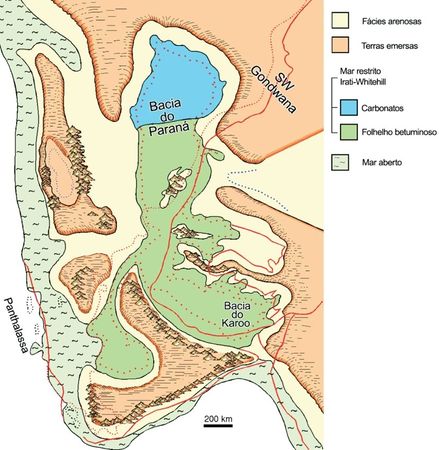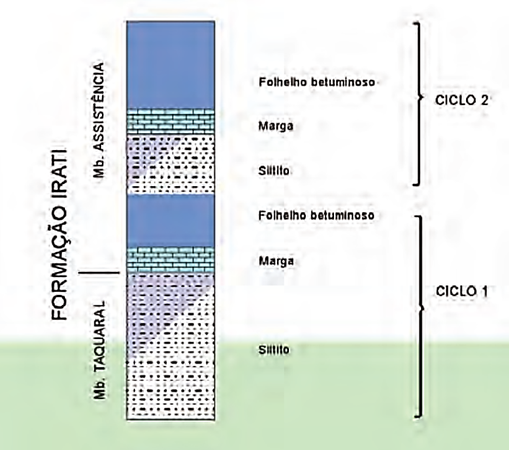Irati Formation
| Wiki Write-Off Entry | |
|---|---|

| |
| Student Chapter | Federal University of Rio Grande do Sul |
| Competition | June 2015 |
The Irati Formantion was deposited during the Gondwana I Supersequence, in the Permian, Artiskian age (278.4 ± 2.2 Ma until 275.6 ± 0.7 Ma)[1] it recorded the transition between the marine influence of the Pantalassa paleo-ocean in the Parana Basin to continental deposition. It preserves the evolution of the Gulf of Irati-Whitehill, which was an epicontinental sea of a wide extension, with evidence for anoxic (Figure 1).[2][3]
At this time, the Paraná Basin was in a "Sag tectonic style", with a very slow subsidence rate, within a marine ramp system of an inner basin of mixed origin (siliclastic and carbonates), with paralic conditions, alternating with storm dominated conditions.
These factors inhibited sandstone deposition, which occurred with low accumulation rates, as thin siliciclastic sediments interbedded with organic rich beds and carbonates. Therefore, grey siltstones and grey bituminous shale layers were preserved, interbedded with marl, calcareous rocks, and thin mudstones. The configuration of the Irati Formation facies can be divided into the Taquaral and Assistencia Members (Figure 2), according to Milani[4].
The Irati Formation contains a lot of fossils, which are also found in related basins, such as the Mangrullo Formation in Uruguay and Whitehill Formation in the south of Africa.[2] This allowed Alfred Lothar Wegener to use a specific fossil, a Mesosaurus reptile, as evidence of continental drift. This theory began a revolution in our concept of the term "deep" geologic time.
Figure 1. Paleogeographic setting of the restricted Irati-Whitehill Sea[4]
Figure 2. Sedimentary cycles of Irati Formation[4]
References
- ↑ Santos, R. V., P. A. Souza, C. J. S. de Alvarenga, E. L. Dantas, M. M. Pimentel, C. G. de Oliveira, and L. M. de Araújo, 2006, Shrimp U–Pb zircon dating and palynology of bentonitic layers from the Permian Irati Formation, Paraná Basin, Brazil: Gondwana Research, v. 9, no. 4, p. 456–463.
- ↑ 2.0 2.1 Lavina, E. L., 1991, Geologia sedimentar e paleogeografia do Neopermiano e Eotriássico (intervalo Kazaniano-Scythiano) da Bacia do Paraná: Tese de Doutorado, Programa de Pós-Graduação em Geociências, Instituto de Geociências, Universidade Federal do Rio Grande do Sul, Porto Alegre, 333 p.
- ↑ Milani, E. J., J. H. G. Melo, P. A. Souza, L. A. Fernandes, and A. B. França, 2007b, Bacia do Paraná: Boletim de Geociências da PETROBRAS, v. 15, no. 2, p. 265–287.
- ↑ 4.0 4.1 4.2 Milani, E. J., A. B. França, and R. A. Medeiros 2007a, Rochas geradoras e rochas-reservatório da Bacia do Paraná, faixa oriental de afloramentos, Estado do Paraná: Boletim de Geociências da PETROBRAS, Rio de Janeiro: v. 15, no. 1, p. 135–162.

